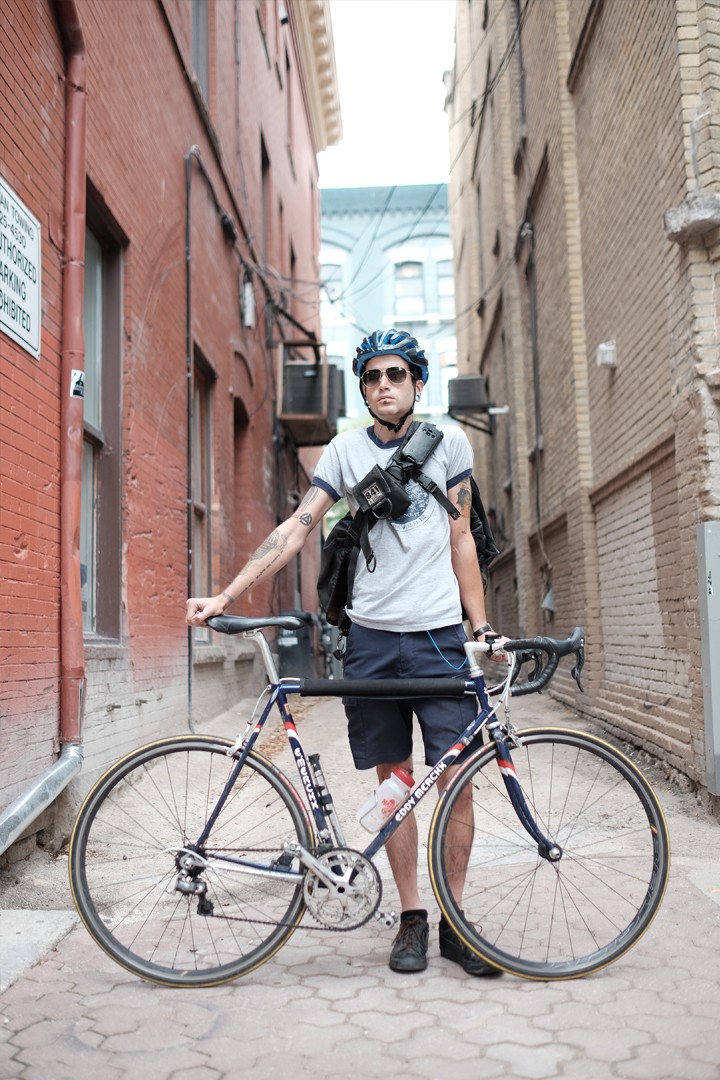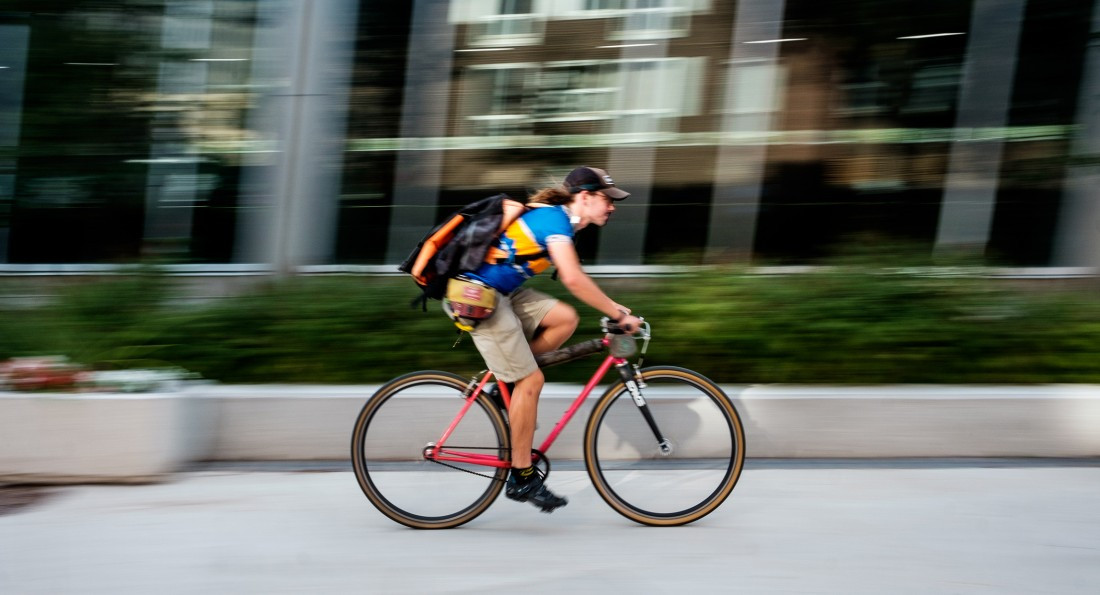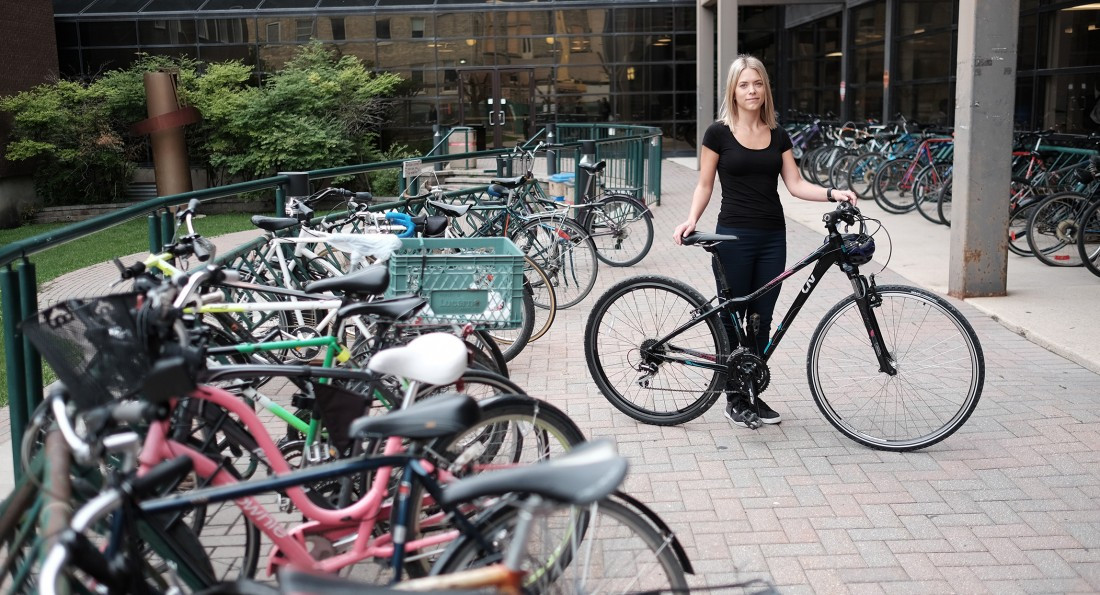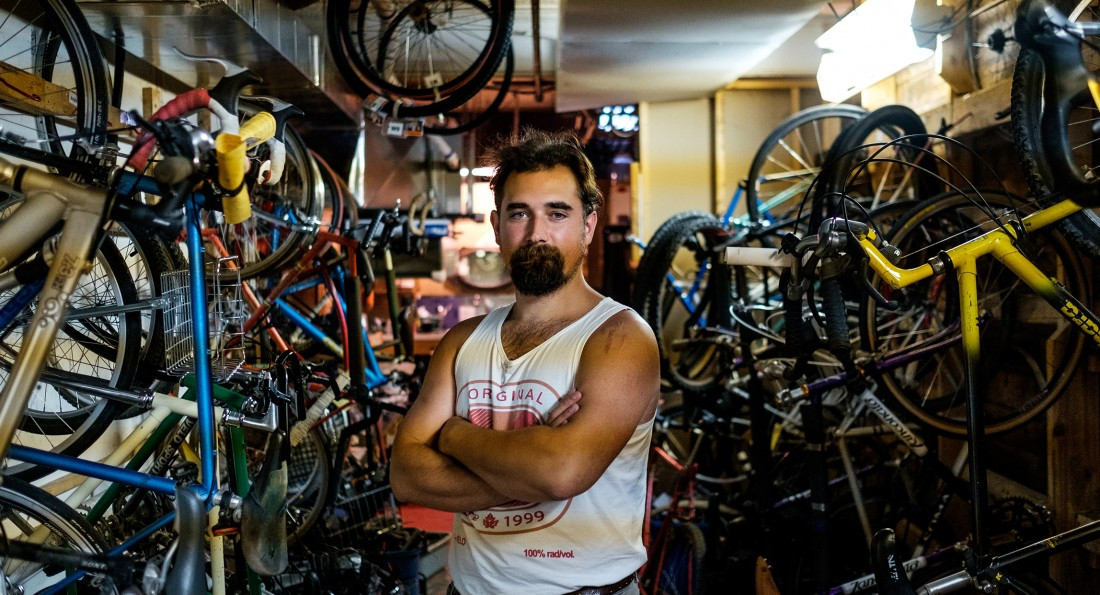Reunite with your ride
How cyclists can improve their chances of recovering a stolen bike
Bike theft is on the rise in Winnipeg, but stories of bicycle recovery offer hope and useful lessons for all riders. What would you do if your bicycle was stolen? How could you increase your chances of getting it back?
The basic advice of locking a bike with a good U-lock in combination to a cable lock, locking it properly and locking it to an immovable object could help deter some thieves. But is there a type of bike that gets stolen more often or that would be easier to recover? That depends on why the bike is being stolen in the first place.

Ryan Woozley is a local courier who watches for stolen bikes.
A bike-stealing culture
“These thieves that are out with the tools, and they’re out to steal bikes, to steal parts, they know bikes … they will be dissuaded by ugly bikes, crappy bikes, bikes that are flamboyantly decorated or that are too difficult to steal,” Will Belford, shop manager at Natural Cycle, says.
“But I think the main reason why people steal bikes is because they want to ride the bike.”
Kristen Andrews’s blue ‘60s vintage bicycle was stolen while she was working at a polling station. She posted about it on Facebook, and less than 12 hours later, an acquaintance spotted the bike – with a flat tire, leaning against a tree outside the Union Gospel Mission – and watched it until Andrews could come collect it.
“Somebody had taken it from the school and ridden it around, and then it wound up over at the shelter,” Andrews says.
While Andrews was lucky to get her bike back, this kind of theft is not uncommon in our city.
“There’s a really strong bike-stealing culture in our town,” Belford says.
“[People] steal it to ride it and they ride it around until it breaks and then they just kick it to the curb, they leave it on the tracks or they leave it in a field or they’ll push it into the river.”
Most of these types of thefts are opportunistic, Belford says, perhaps a bike is left unattended, or locked with a simple cable lock.
But even the recommended U-locks are not enough to protect against modern tools.
Daniel Jangula was picking up his car on Sherbrook Street when he saw a man sawing through a U-lock, in broad daylight, across the street. He decided to approach the individual and intervene in a possible theft.
The man stated the bike was his and he was missing the key, but Jangula was not convinced, so he called 911 and filed a report.
“I guess I was trying to contribute or help out at least, and just let him know that it’s not going unnoticed,” Jangula says. By the time he finished the call, the man, saw and bike were long gone.
So with all the bikes that get stolen, is there any hope for getting them back?
Bicycle recovery starts before the theft
Most tactics that have helped Winnipeggers recover their bicycles involve documenting and registering a bike before there’s even the potential of theft.
The City of Winnipeg offers a bicycle registration program that matches rightful owners with recovered bicycles. A registration costs $6.40 per bicycle and is good for a lifetime. The city currently has over 8,000 bicycles registered, Marcia Fifer, licensing coordinator for the City of Winnipeg, says.
The City’s bicycle recovery unit works with the Winnipeg Police Service (WPS), and they also collect abandoned bikes reported to 311 by businesses or individuals.
In 2015, they recovered 760 bikes, and 18 were returned to their owners.
“Where we do find a match, we are able to take those steps to reunite people with their bikes,” Fifer says. She cautions that the number of returned bikes may seem low because it doesn’t include bicycles returned by the WPS.
If you’re buying a new bike from a shop, stores may keep records of serial numbers, and this information can also be found on receipts. Serial numbers are one of the few ways bike owners can identify their own bike – as long as the number and owner are linked somehow.
Lauren Gislason got lucky when her bike, stolen in April of this year, was brought in for repair at the shop she originally bought it from, Bikes and Beyond.
“I guess they looked at him, looked at the bike – it’s an extra-small women’s Giant hybrid bike – and it didn’t add up, so they took it into the back and typed up the serial number and came up with my name,” Gislason says. The shop held onto the bike until they could return it to Gislason, who then followed up with police.
Some higher end locks, such as the Kryptonite brand, also come with an anti-theft program which will pay out the value of the bike if it is stolen. The program is an additional cost, and bike owners need to register when they purchase the lock.
Another useful tactic is to have current pictures of your ride, or even better, a selfie with you and your bicycle. This can help with police reports or tracking down the bike through more informal means.
If you know that there are tens, or hundreds, of bikes like yours out on the streets, adding some distinctive markings, accessories or parts could help your bike stand out, especially when friends and other community members are watching for it.
“There’s a guy I know a few years ago who had his bike stolen, but he had a sticker with his name on it,” Ben Ryan, local bicycle courier, says.
“He posted a photo of it and he’s like, there’s a sticker with my name on it, so people looked for that,” and luckily, his bicycle was found and returned within a week.
Bikes with custom builds or unique modifications are more likely to stand out and be spotted. “Because we hand-build wheels and we get in certain brands of bicycle frame that can only be hand-built, we know which ones are ours out there,” Belford says.
“It happened just the other day, a courier was riding around and says ‘Hey, I see one of your bikes, I don’t like the look of the person who’s on it, did it get stolen?’ Yes, yes it did. So that’s a nice feature of our bikes.”
Buying “unique one-off bikes… shouldn’t be expected of everyone,” Ryan says. Other markings or add-ons can help distinguish a bike, although once a bike is stolen, these can also be removed or painted over.

Lauren Gislason’s bike was stolen and recovered months later by a bike shop.
Bringing it home
Even with the best laid plans, if someone is determined to steal a bike, they will, Belford says. And after a theft, there are a few steps to take that can help with bicycle recovery.
The first one is to file a police report. Constable Rejeanne Caron, downtown safety coordinator with the WPS, urges those with stolen bicycles to file a report as soon as possible.
“We can only do so much, but the public really needs to be a part of it as well. And what we’re finding is that if we don’t have the information, we can’t put the owner of the bike to the bike to the accused,” Caron says.
Bikes recovered through the City’s bike recovery program and through the WPS can be identified as stolen if their serial number matches one provided on a police report.
“A lot of the frustration for investigators is they can’t piece the two together. I know guys have seized very expensive bikes but have no clue who the bike belongs to,” Caron says.
Stolen bikes can sometimes show up on sales sites like Kijiji, and victims of theft can scan these sites for signs of their lost bicycle.
If a stolen bike is spotted being sold online, Caron advises that it’s best to take a screenshot of the post and report it to the non-emergency line. That way, she says, if the post goes down, the screenshot can serve as evidence.
It can also be helpful to post a picture of your bike to a stolen bike recovery group.
In June 2014, Diana Fred started the group Winnipeg Bike Watch on Facebook. “It was after another bike got stolen, or a friend of mine’s, or something happened…(I thought) maybe this will help, maybe the internet will work for us,” Fred says. Other groups, including Winnipeg and Area Stolen Bikes, exist on Facebook for similar purposes.
“We’ve had a few people come back and say, yes, their bike has been found, so there has been a few,” Fred says.
She’s seen three recovered bikes in her group. “It doesn’t seem like a very big number, but it does create hope that people will get their bikes back.”
Having a community of people out on the street watching for stolen bikes could theoretically lead to more stolen bikes being recovered.
Bike couriers ride the streets all day, and usually also have a keen eye for bikes as well. Some help out by watching out for stolen bikes – those they know about, at least.
“It’s all just based on social media and Facebook and word of mouth,” Ryan says.
“If a good friend of ours has a bike stolen, we text everyone a photo or a description, or sort of keep it in the back of your mind, keep an eye out for it.”
Ryan Woozley, another local bike courier, checks the stolen bike groups on Facebook, as well as Kijiji, daily, to stay current on which bikes are missing.
“(I’ll) just be out and about everywhere, looking at bikes, passing people, locking up next to their bikes, and if anything rings a bell, I’ll pop open one of those pages where I think I saw the stolen bike, and verify whether it is or isn’t that bike,” Woozley says.
Though there are some possible markers of a stolen bike (a U-lock left hanging from the frame, a rough spray paint job on a fancy bike), it’s difficult to tell at a glance if a bike is being ridden by its rightful owner.
Assessing a stolen bike is “dangerous, because then you start to get into assessing people, more than you’re assessing bikes. What does a stolen bike look like? It looks like a bike,” Belford says.
However, if you believe you’re seeing a stolen bike being ridden around, Caron advises to call 911 “because it is a crime in progress.” She urges the public not to get involved in recovering stolen bikes because “you just don’t know who you’re dealing with.”
“You don’t want anyone getting hurt, or getting into any kind of confrontation.”
None of these tactics will guarantee that you will recover your bike after a theft. But for cyclists in Winnipeg who love and depend on their rides, anything that could help is worth a try.
Published in Volume 71, Number 1 of The Uniter (September 8, 2016)










